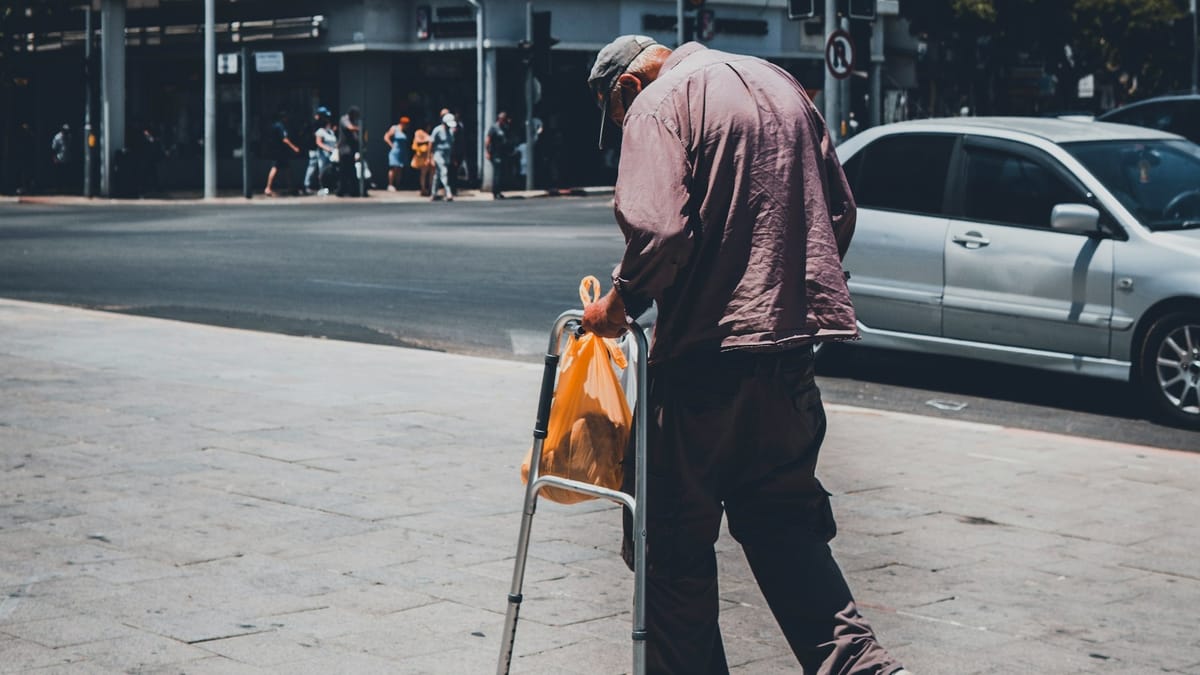The Silent Thief: How Sarcopenia Affects Aging and What You Can Do About It
Sarcopenia: The Silent Thief of Aging. Age-related muscle loss affects millions, increasing fall risks & severe injuries. Understanding its causes is key to safeguarding older adults' well-being & promoting healthy ageing

Have you ever wondered why maintaining muscle strength becomes more challenging as we age? Or why hip fractures are more prevalent among older adults, especially women? These aren’t just coincidental changes associated with getting older, they are often linked to a lesser-known condition called: Sarcopenia. Characterised by the age-related loss of muscle mass and strength, sarcopenia is a growing concern among ageing populations, affecting millions of people worldwide. But why should this matter to us?
Understanding sarcopenia is not just crucial for older adults and their families, but also for healthcare professionals, researchers, and industry experts striving to improve health outcomes for this vulnerable population. With an ageing global demographic, the repercussions of sarcopenia extend far beyond muscle deterioration. It can lead to decreased mobility, higher risks of falls, and, as a result, a greater likelihood of severe injuries such as hip fractures. These fractures can drastically diminish a person’s quality of life and independence, and even increase the risk of mortality. Thus, addressing sarcopenia is a key strategy in safeguarding the well-being of older adults.
Addressing sarcopenia is not just about muscle mass, but about tackling a multifaceted issue that encompasses nutrition, physical activity, and overall lifestyle. Healthcare professionals play a pivotal role in identifying individuals at risk and providing effective interventions. For researchers, understanding the underlying mechanisms of sarcopenia and exploring new treatment strategies can lead to innovative solutions that enhance muscle health. And for industry experts, there is an opportunity to develop products and programs that promote healthy ageing and help older adults maintain their strength and mobility.
By integrating knowledge from diverse fields, we can create a comprehensive approach to combat sarcopenia and its associated risks, such as hip fractures. Recognizing the early signs and implementing preventative measures can make a substantial difference in the lives of countless individuals. This article will delve into why sarcopenia should be on everyone’s radar, the role of nutrition and lifestyle in its management, and the steps we can take to reduce its impact on older adults. With the right strategies, we can not only slow down muscle loss but also promote healthier, more active ageing for generations to come.
Understanding the Age-Related Muscle Loss and Its Implications
As we get older, the natural ageing process leads to various physiological changes, one of which is the gradual loss of muscle mass and strength. But why exactly does this happen? There are several factors that contribute to this decline, with decreased physical activity being one of the main culprits. As people age, they tend to adopt a more sedentary lifestyle, either due to reduced mobility, chronic pain, or simply a lack of motivation to engage in regular exercise. This decrease in physical activity creates a cycle of muscle disuse, leading to a reduction in both muscle size and strength.
In addition to inactivity, changes in hormone levels play a significant role in muscle loss. Hormones such as testosterone and oestrogen, which support muscle maintenance, naturally decline with age. Lower levels of these hormones can result in reduced muscle protein synthesis and increased muscle breakdown, further accelerating the onset of sarcopenia. Similarly, growth hormone and insulin-like growth factor-1 (IGF-1), which also regulate muscle growth and repair, decrease with age, contributing to muscle wasting.
Another important factor is the alteration in protein metabolism. Older adults often experience inefficient protein synthesis and repair processes, which means that their muscles are not as effective at using dietary protein to build and maintain muscle tissue. Even with adequate protein intake, the ageing body’s reduced ability to utilise protein can hinder muscle growth and recovery, making it easier for muscles to atrophy.
Chronic diseases, such as rheumatoid arthritis, diabetes, and cardiovascular conditions, can also impact muscle health. These diseases affect the body’s capacity to use nutrients efficiently and can interfere with protein synthesis. Moreover, they often lead to a sedentary lifestyle, exacerbating muscle loss. Certain medications, such as corticosteroids or some types of cancer treatments, may have muscle-wasting side effects, further complicating the maintenance of muscle mass in older adults.
Altogether, these factors create a challenging environment for maintaining muscle health in ageing individuals. Decreased physical activity, hormonal shifts, impaired protein metabolism, chronic diseases, and specific medications all contribute to the onset and progression of sarcopenia. Understanding these causes is crucial for developing effective interventions to prevent or delay the decline of muscle mass and strength in older adults.
Life Expectancy Lost Due to Hip Fractures and Strategies for Bone Health
Hip fractures are a serious concern for older adults, often leading to significant health complications and a reduced life expectancy. Several studies have highlighted the impact of hip fractures on longevity, revealing an average loss of life expectancy ranging from one to five years, depending on age, health status, and the individual’s ability to recover. What makes these fractures even more concerning is the elevated risk of mortality within the first year following the fracture. In fact, research shows that mortality rates can increase by as much as 20% to 30% during this period. This heightened risk is often due to complications such as immobility, infections, and the onset of other chronic conditions that may arise due to prolonged inactivity.
One of the primary factors linking muscle health to bone strength is a process known as *mechanotransduction*. Strong muscles help maintain and even increase bone density through the force they exert on the bones during physical activities. However, when muscles are weak or diminished, they cannot provide the necessary stimulus for bone maintenance, leading to a decline in bone density and an increased risk of osteoporosis, a condition characterised by fragile bones that are more susceptible to fractures.
To improve bone density and overall musculoskeletal health, older adults are encouraged to engage in a variety of exercises. Weight-bearing activities such as walking, jogging, dancing, and stair climbing help maintain bone strength by applying pressure to the bones. Resistance exercises, including weightlifting, using resistance bands, and bodyweight exercises like push-ups, are equally beneficial, as they enhance both muscle and bone strength. Impact exercises, such as jumping jacks, skipping, and jumping rope, can also be incorporated to provide the necessary mechanical load that stimulates bone formation.
Nutrition is another key component in managing sarcopenia and promoting bone health. Adequate protein intake is essential for muscle synthesis and repair, as proteins are the building blocks of muscle tissue. Older adults should aim to consume at least 1.0 to 1.2 grams of protein per kilogram of body weight each day to support muscle maintenance. Additionally, meeting daily caloric needs is important to provide sufficient energy for both muscle and bone upkeep.
Vitamin D and calcium are crucial for bone health. Vitamin D enhances calcium absorption in the body, while calcium itself is a vital component of bone structure. For older adults, the recommended daily intake is 800-1000 IU of vitamin D and 1200 mg of calcium. Studies have consistently shown that adequate levels of these nutrients help reduce the risk of fractures and support overall skeletal health. Thus, healthcare professionals often recommend vitamin D and calcium supplements, especially for those at risk of deficiencies.
With the right combination of exercise, nutrition, and targeted supplements, older adults can effectively manage sarcopenia and reduce the risk of debilitating hip fractures, ultimately promoting a healthier and more active ageing process.
The Role of Calcium, Vitamin D, and Absorption Factors
Maintaining adequate levels of calcium and vitamin D is crucial for bone health, but various factors can interfere with their absorption. Age-related changes in the digestive system, such as reduced gastric acid production, can limit calcium absorption, while certain gastrointestinal conditions like celiac disease or inflammatory bowel disease can impair vitamin D uptake. Additionally, low magnesium levels, which are common in older adults, can further hinder calcium utilisation. For vitamin D, skin changes with ageing, such as decreased thickness and altered capacity to synthesise vitamin D, also reduce its efficiency.
One of the best sources of vitamin D is sunlight. When exposed to sunlight, the skin produces vitamin D, which is then converted by the liver and kidneys into its active form. However, balancing sun exposure is crucial. While some sunlight is necessary, too much can increase the risk of skin damage and skin cancer. Experts generally recommend about 10-30 minutes of sun exposure a few times a week, depending on skin type and environmental conditions. For individuals who have limited sun exposure or live in regions with low sunlight, dietary sources and supplements may be necessary.
When it comes to dietary sources of calcium, traditional Chinese cuisine offers a variety of nutrient-rich options. Foods such as tofu, which is often fortified with calcium, and dairy products like milk and yoghourt can be excellent sources. Leafy green vegetables, including bok choy and Chinese cabbage, as well as nuts, seeds, and small fish like sardines (often eaten with bones), also provide high levels of calcium.
For those with significant bone density loss or osteoporosis, medications may be recommended. *Bisphosphonates* are among the most commonly prescribed drugs, as they slow down bone resorption and help maintain bone density. However, long-term use has been linked to rare side effects like atypical fractures. *Denosumab* is another effective option that works by inhibiting bone resorption, but it requires continuous administration, and stopping it can lead to rapid bone loss. Other alternatives include selective oestrogen receptor modulators (SERMs), calcitonin, and parathyroid hormone analogs, each with its own benefits and risks.
Non-medical interventions are equally important for managing bone health. Regular weight-bearing and resistance exercises, such as walking and strength training, are effective for maintaining bone density and muscle strength. Proper nutrition, including a diet rich in calcium and vitamin D, is essential. Lifestyle modifications such as smoking cessation and moderating alcohol intake can also have a significant impact on bone health. Smoking accelerates bone loss and impairs calcium absorption, while excessive alcohol consumption has been associated with decreased bone density.
For a 70-year-old female, a comprehensive plan should include weight-bearing exercises like brisk walking, resistance training to build muscle strength, and a balanced diet with ample calcium and vitamin D. Fall prevention measures, such as ensuring proper lighting at home, wearing non-slip footwear, and removing hazards, are crucial to reducing the risk of fractures. When necessary, medications such as bisphosphonates or denosumab may be considered, depending on the individual’s bone health and risk factors.
A Wake-Up Call: How Sarcopenia Impacted My Life
“I always considered myself a strong, independent person,” says Marta, a 72-year-old retired schoolteacher from Madrid. “I used to enjoy long walks in the park, gardening, and keeping up with my grandchildren. But a few years ago, I started noticing that I was losing my stamina. Walking up the stairs became a challenge, and carrying groceries left me feeling unusually fatigued. I thought it was just part of getting older, but then I had a serious fall.”
That fall led to a hip fracture, a life-altering event that Marta says was a wake-up call. “The doctors told me that my muscle loss—something I didn’t even know was happening—had weakened my bones and increased my risk of falling. After surgery and months of physical therapy, I realised I couldn’t ignore my health anymore.” Determined to regain her strength and independence, Marta began working with a nutritionist and a physiotherapist. “They introduced me to resistance exercises and a new diet plan with more protein, calcium, and vitamin D. It wasn’t easy at first, but gradually I started to feel stronger. I’m still not back to where I was, but I’ve come a long way.”
Marta’s story highlights the impact of sarcopenia on daily life and the importance of addressing muscle and bone health early. “If I’d known what I know now, I would have started these changes years ago. My advice? Don’t wait for a fall or fracture to get serious about your health. Start taking care of your muscles and bones today, you’ll thank yourself later.”
Key TakeAways
- Sarcopenia is the age-related loss of muscle mass and strength, impacting millions and affecting mobility and overall health.
- Preventing sarcopenia involves addressing nutrition, physical activity, and lifestyle to maintain muscle mass and enhance quality of life.
- Hormonal changes contribute to muscle loss; testosterone and oestrogen decline with age, reducing muscle protein synthesis and increasing breakdown.
- Inactivity leads to muscle disuse, creating a cycle that exacerbates muscle atrophy and weakness in older adults.
- Chronic diseases and medications can hinder muscle health, affecting nutrient usage and complicating the maintenance of muscle mass.
- Hip fractures significantly reduce life expectancy and increase mortality risk, especially within the first year after the fracture.
- Exercise is essential; weight-bearing, resistance, and impact activities improve bone density and muscle strength, reducing the risk of fractures.
- Nutrition plays a critical role; adequate protein, vitamin D, and calcium intake support muscle maintenance and bone health.
- Calcium and vitamin D absorption can be hindered by age-related digestive changes, so supplements may be necessary for older adults.
- Comprehensive plans for older adults should include exercise, nutrition, and fall prevention strategies to enhance bone health and overall well-being.
Your Top Questions Answered
What is sarcopenia?
Sarcopenia is the age-related loss of muscle mass and strength, leading to decreased physical performance. It typically begins in the mid-30s and accelerates after age 60, significantly impacting mobility and overall health in older adults.
What causes sarcopenia?
Sarcopenia is caused by various factors, including reduced physical activity, hormonal changes, chronic diseases, and impaired protein metabolism. Lifestyle choices, such as poor nutrition and inactivity, further contribute to muscle loss as individuals age.
How can sarcopenia be prevented?
Prevention of sarcopenia involves maintaining an active lifestyle through regular resistance training and aerobic exercises, alongside a balanced diet rich in protein, calcium, and vitamin D to support muscle and bone health.
What are the symptoms of sarcopenia?
Symptoms of sarcopenia include muscle weakness, fatigue, decreased mobility, difficulty performing daily activities, and an increased risk of falls and fractures. Early detection and intervention can help manage these symptoms effectively.
Can sarcopenia be treated?
While sarcopenia cannot be completely reversed, its effects can be mitigated through exercise, nutrition, and lifestyle changes. Resistance training, adequate protein intake, and supplements like vitamin D can help improve muscle strength and overall function.
Conclusion
In conclusion, sarcopenia, the age-related loss of muscle mass and strength, poses significant risks to older adults, impacting mobility and overall health. This condition is influenced by multiple factors, including decreased physical activity, hormonal changes, chronic diseases, and impaired protein metabolism. The consequences of sarcopenia extend beyond muscle deterioration, with hip fractures being a critical concern that can lead to reduced life expectancy and increased mortality risk, particularly within the first year post-fracture.
Addressing sarcopenia requires a multifaceted approach that encompasses proper nutrition, regular exercise, and lifestyle modifications. Adequate protein, calcium, and vitamin D intake, along with resistance and weight-bearing exercises, are essential for maintaining muscle and bone health. Recognizing the early signs of sarcopenia and implementing preventative measures can profoundly enhance the quality of life for older adults, allowing them to maintain their independence and vitality.
Understanding sarcopenia is not just crucial for older adults and their families, but also for healthcare professionals and researchers working to improve health outcomes for this vulnerable population. By prioritising muscle health and adopting proactive strategies, we can help ensure healthier, more active ageing for generations to come. Ultimately, the fight against sarcopenia is a collective responsibility that calls for awareness, education, and action to safeguard the well-being of our ageing communities.
References
https://pubmed.ncbi.nlm.nih.gov/24122149
https://pubmed.ncbi.nlm.nih.gov/31478616/
https://pubmed.ncbi.nlm.nih.gov/29092748/
https://www.nature.com/articles/s41586-019-1232-2
https://onlinelibrary.wiley.com/doi/full/10.1111/jgs.15990
https://pubmed.ncbi.nlm.nih.gov/2892899
https://pubmed.ncbi.nlm.nih.gov/22235261
https://www.health.harvard.edu/staying-healthy/the-impact-of-sarcopenia-on-aging
https://www.hopkinsmedicine.org/health/conditions-and-diseases/sarcopenia
https://www.acsm.org/blog-detail/acsm-certified-blog/2020/06/15/sarcopenia-prevention-and-treatment
https://my.clevelandclinic.org/health/diseases/21181-sarcopenia




